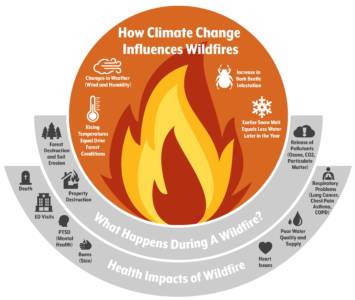Climate Change in Colorado
WHAT IS CLIMATE CHANGE?
First off, what is the difference between climate and weather?
Climate and weather are words that are often used interchangeably, but it’s helpful to understand the difference between them. Weather is the short term changes we see in temperature, clouds, rainfall, humidity, and wind in an area. The climate of a region is the average of weather, measured over years. For example, the climate of Arizona is much hotter and drier than the climate of Washington or Oregon.
“If you don’t like the weather in Colorado, just wait a few minutes.”
“Climate Change” refers to any significant changes in average weather conditions over a long period of time, such as several decades or more. These changes include things besides just temperature as well. For example, places could become wetter or drier or there may be more extreme weather events, like droughts, wildfires, and hurricanes
The weather can change from day to day, but when the climate is changing, this can mean big problems for the health of our planet. Here in Colorado, we can often have a warm, sunny day and then a snow squall the next day. These changes in weather are dramatic, but are much different than a significant change to our climate over decades.
Climate Change vs. Global Warming
 Just as the words “climate” and “weather” are used interchangeably, so are “climate change” and “global warming.” Global warming refers to the Earth’s rising surface temperature. Climate change, on the other hand, refers to that warming AND everything that goes along with a global change in climate – like melting glaciers, droughts, forest fires, sea level rise, and hurricanes. You can think of global warming as one symptom of a much larger problem – climate change.
Just as the words “climate” and “weather” are used interchangeably, so are “climate change” and “global warming.” Global warming refers to the Earth’s rising surface temperature. Climate change, on the other hand, refers to that warming AND everything that goes along with a global change in climate – like melting glaciers, droughts, forest fires, sea level rise, and hurricanes. You can think of global warming as one symptom of a much larger problem – climate change.
Is the Earth’s Climate Changing?
The earth’s climate is always changing, and it always has been. The earth cycles between warmer and cooler periods, which last for thousands of years. So why are we so concerned with “Climate Change”?
Scientists have made observations which show that the Earth’s climate has been warming very rapidly in a short amount of time. According to NASA, over the past 100 years, the global average temperature has risen a little more than one degree Fahrenheit.
“But it is only one degree!” While this amount may not seem like much, small changes in the earth’s average temperature can lead to BIG impacts. Warming of the Earth’s climate has already caused snow and ice to melt, and, in turn, caused oceans to rise.
Here is a good graph of how the rates of the earth’s warming have been increasing dramatically in recent years:
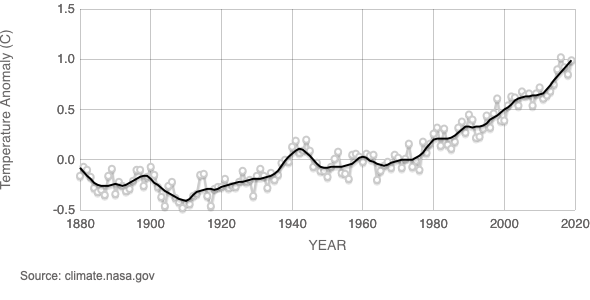
Explore this interactive global land-ocean temperature index from NASA’s Goddard Institute for Space Studies.
You can learn more about climate change here on our 350’s Climate Change Basics Page.
Video resources:
WHAT IS CAUSING CLIMATE CHANGE?
As you may have heard, some of the causes of climate change are natural. These include changes in Earth’s orbit, the amount of energy coming from the sun, ocean changes, and volcanic eruptions. But most scientists agree that this does not, and cannot, account for the recent increases in temperature. This rapid change has been caused by humans.
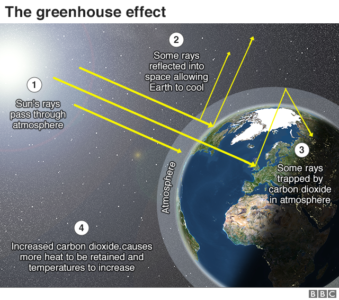
https://www.bbc.com/news/science-environment-24021772
We have impacted the earth by deforestation and the burning of coal, oil, and gas. This adds heat-trapping gases such as carbon dioxide, methane, and nitrous oxide into the air. These gases are called ‘greenhouse gases.’
Greenhouse gases get their name from, you guessed it, greenhouses! And while greenhouses aren’t responsible for climate change or the gases that bear their name, understanding how a greenhouse works can help us understand how the earth is warming.
If you’ve ever been inside a greenhouse or a botanical garden, you understand how warm they are. This higher temperature is what allows tropical plants from around the world to be grown in places like Colorado. Greenhouses work by using glass ceilings, which allow light to get in and that light is then trapped inside the space, making it warmer than the air outside.
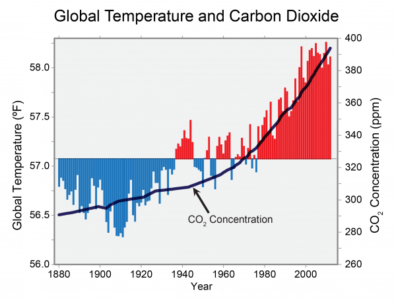 When humans burn coal and other fossil fuels like gasoline, the greenhouse gases that are emitted enter the atmosphere and begin to work in a similar way to the glass ceiling of a greenhouse. The sun’s energy enters through this “invisible ceiling” and the heat is trapped inside by the greenhouse gas molecules, warming our planet.
When humans burn coal and other fossil fuels like gasoline, the greenhouse gases that are emitted enter the atmosphere and begin to work in a similar way to the glass ceiling of a greenhouse. The sun’s energy enters through this “invisible ceiling” and the heat is trapped inside by the greenhouse gas molecules, warming our planet.
As you can see in this chart from the U.S. Global Change Research Program, the global annual average temperature (as measured over both land and oceans) is directly correlated to the concentration of the greenhouse gas carbon dioxide (CO2).
What does the IPCC Special Report on 1.5C global warming actually mean?
How does the latest National Climate Assessment fit in? What to make of recent headlines that CO2 emissions are at an all-time high? What about permafrost melting? Tipping points? Feedback loops? What does it all mean?
Professor Scott Denning explains recent news reports, and relates them to state and local climate action plans. He is a professor of atmospheric science at Colorado State University in Fort Collins, and he spoke by invitation of the Denver chapter of 350 Colorado. A condensed version of his talk is at https://youtu.be/ypXNoIuUq4Q . You can view the entire speech here: https://www.youtube.com/watch?v=DbFgR5d7R3o
WHAT DOES THIS MEAN FOR COLORADO?
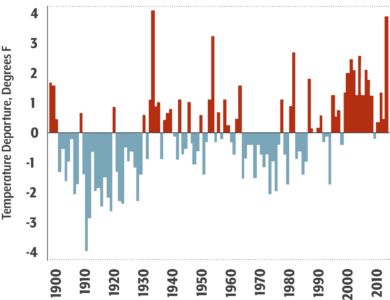
Colorado Temperature Trends 1900-2012
There is no doubt Colorado’s climate is changing. According to multiple independent measurements, Colorado temperatures have increased by approximately two degrees (F) between 1977 and 2006. According to the Colorado Health Institute, this increase ranks Colorado as the 20th fastest-warming state since 1970.
You may be asking, “it’s only two degrees, what effect does this really have?” Historically, that large of a temperature change took place over thousands of years, not a few decades. Climate change affects every single part of Colorado, from the thirsty forests ripe for wildfires to the mountains where less snowpack accumulates to the farmlands where less water is available to meet agricultural needs. We can see the effects of this change in person as wildfires occur more frequently and burn more acreage across our state.
Snowpack
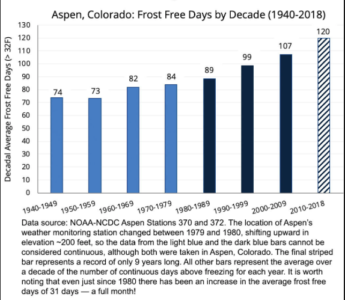
Source: Aspen Daily News
Changes in temperature and precipitation are affecting Colorado’s snowpack, or the amount of snow that accumulates on the ground. The snowpack has decreased since the 1950s in most of the Western United States, due to earlier melting and less precipitation falling as snow.
According to the Environmental Center at the University of Colorado Boulder, scientists predict that snowpack in the Southern Rockies will drop 50% this century and the Sierra Nevada snowpack is expected to decrease by 90%.
This diminishing snowpack can shorten the ski season as well as impact other forms of winter tourism and recreation. Basically, the earlier melting means that spring starts a little sooner and summer lasts a little longer every year.
Click here to see a time lapse video of changing snowpack
Less snow also means less water…
Water Supply
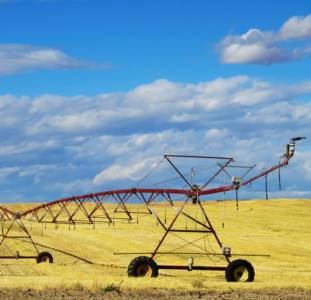
Photo by Peter Gonzalez on Unsplash
Less snowpack doesn’t just affect skiers. Snowpack accounts for 70% of Colorado’s water supply. Climate change has decreased the natural flow of the Colorado River by 20% and much of the decline is due to snowpack and evaporation.
The Colorado river supplies water for 40 million people and millions of acres of farmland, and the decline is expected to continue unless we do something to reverse climate change. This river not only provides water to our state, but it covers 246,000 square miles, including Arizona, California, New Mexico, Nevada, Utah, and Wyoming.
Wildfires
Higher temperatures and drought are likely to increase the severity, frequency, and the extent of
wildfires in Colorado. These wildfires have the potential to cause destruction to property, livelihoods, and human health. The smoke created by wildfires can reduce air quality and increase medical visits for chest pains, respiratory problems, and heart problems.
A study published in the Proceedings of the National Academy of Sciences suggests that climate change is playing a significant role in making forests in the western U.S. drier and more likely to burn, increasing the areas affected by forest fires. Earlier springs extend the fire season and droughts increase the amount of fuel available to burn.
Explore the 10 largest wildfires in Colorado’s History.
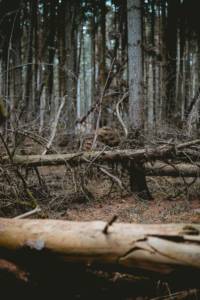
Photo by niklas_hamann on Unsplash
Pine Beatles
If you have been to the mountains recently, there is no doubt that you have seen the devastation caused by the pine beetles, which have killed over 3.4 million acres of trees in Colorado. Rising temperatures and fewer below freezing winter days allow them to live successfully at higher elevation. These dry, dead trees increase the likelihood of large forest fires. This causes authorities to be forced to limit access to hiking and camping, which affects Colorado’s tourism and economy.
Explore the effects of the pine-bark beetles near Granby in this article from the Denver Post.
Changing Ecosystems
The diminishing snowpack allows subalpine fir and other high-altitude trees to grow at higher elevation. But aren’t more trees a good thing? The upward movement of the tree line decreases the extent of alpine tundra, which fragments these ecosystems, possibly causing the loss of some species.
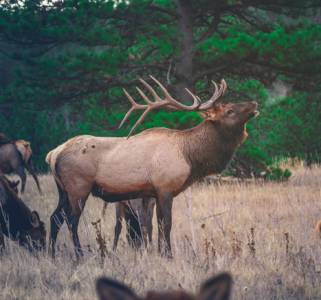
Photo by Byron Johnson on Unsplash
Rising water temperature and the changing chemistries of Colorado’s alpine lakes and streams make it harder for trout, amphibians, and aquatic plants and insects to survive. Their decline will result in a destabilization of entire ecosystems.
Mammals are in turn affected due to changes in their food source caused by warming temperatures. Large Rocky Mountain mammals are being forced to higher elevations. These rising temperatures also bring deadly parasites and disease to these higher altitudes, which further reduce their populations.
In the high Rockies, snowmelt date initiates the plant growing season. The earlier snowmelt date causes earlier flowering in species like the glacier lily. These changes in wildflowers may change resource availability for pollinators like birds and insects and herbivores that depend on them for food.
Health Impacts
Every aspect of climate change affects human health.
It is already happening. It is not our imagination. And it’s only going to get worse. The usual suspects are the most vulnerable populations: pregnant women, children, adults with preexisting health conditions, as well as those with fewer economic and social resources.
There are multiple health effects already seen in Colorado.
- It is becoming harder for Coloradans to breathe. The air has
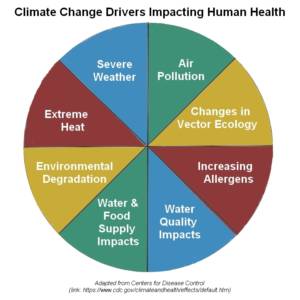 more ozone, air particulates from wildfires, and allergens from the lengthening warm weather seasons.
more ozone, air particulates from wildfires, and allergens from the lengthening warm weather seasons. - Extreme heat days lead to more heat-related illnesses. Most counties in Colorado have experienced nine extreme heat days per year compared to just two per year in the twentieth century.
- Safe drinking water is under threat from an increase in episodes of harmful algal blooms and extreme rainfall, which can overwhelm water treatment centers.
- More severe droughts threaten sources for drinking water and food production, but also lead to the stress of financial hardship on farming and other water-dependent industries.
The Centers for Disease Control has identified eight climate change drivers with the most notable effects on human health. (See Figure.) Many of these compound each other in the ultimate health effects.
Further References:
What Can I Do?
Climate change can feel like an overwhelming problem – after all, it’s a problem that’s affecting the entire world. But while the facts of the climate crisis are stark, we know what we have to do! We need to keep fossil fuels in the ground and transition to renewable energy.
And we’re not alone – there is a worldwide movement to stop climate change. The most important thing you can do is to join people near you who are fighting climate change and working towards a just transition to 100% renewable energy.

